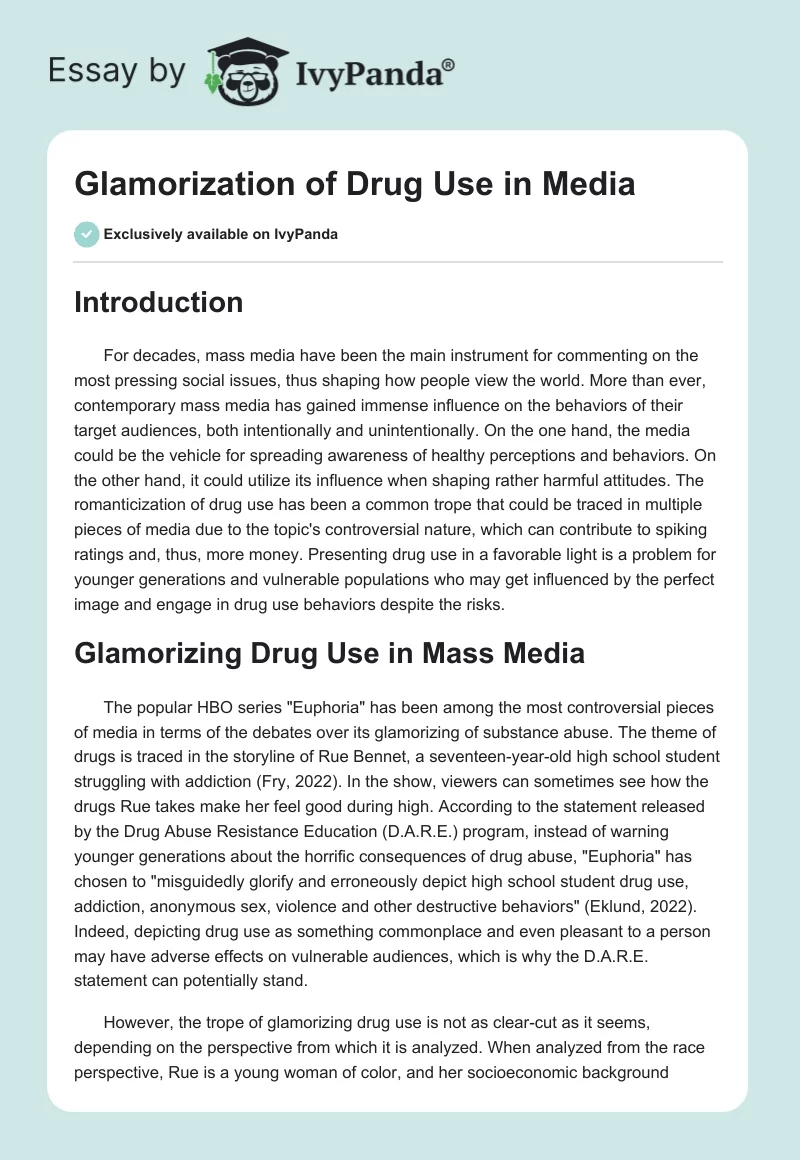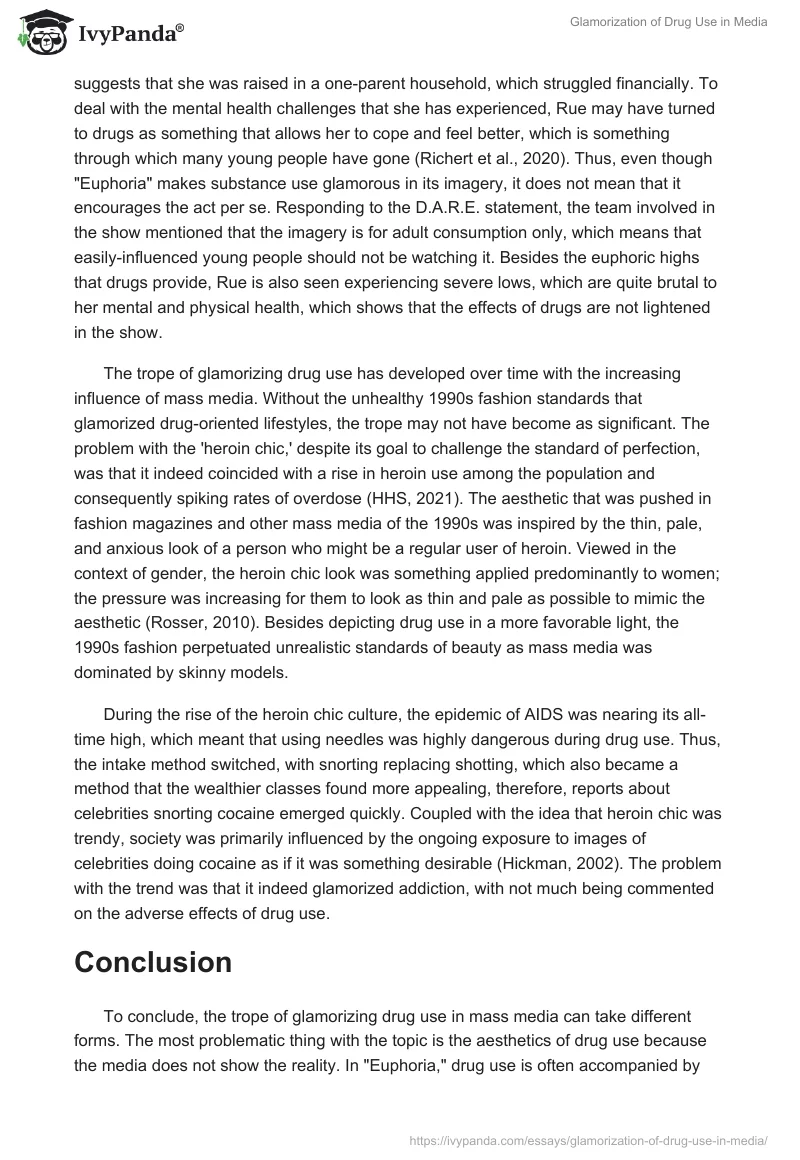Introduction
For decades, mass media have been the main instrument for commenting on the most pressing social issues, thus shaping how people view the world. More than ever, contemporary mass media has gained immense influence on the behaviors of their target audiences, both intentionally and unintentionally. On the one hand, the media could be the vehicle for spreading awareness of healthy perceptions and behaviors. On the other hand, it could utilize its influence when shaping rather harmful attitudes. The romanticization of drug use has been a common trope that could be traced in multiple pieces of media due to the topic’s controversial nature, which can contribute to spiking ratings and, thus, more money. Presenting drug use in a favorable light is a problem for younger generations and vulnerable populations who may get influenced by the perfect image and engage in drug use behaviors despite the risks.
Glamorizing Drug Use in Mass Media
The popular HBO series “Euphoria” has been among the most controversial pieces of media in terms of the debates over its glamorizing of substance abuse. The theme of drugs is traced in the storyline of Rue Bennet, a seventeen-year-old high school student struggling with addiction (Fry, 2022). In the show, viewers can sometimes see how the drugs Rue takes make her feel good during high. According to the statement released by the Drug Abuse Resistance Education (D.A.R.E.) program, instead of warning younger generations about the horrific consequences of drug abuse, “Euphoria” has chosen to “misguidedly glorify and erroneously depict high school student drug use, addiction, anonymous sex, violence and other destructive behaviors” (Eklund, 2022). Indeed, depicting drug use as something commonplace and even pleasant to a person may have adverse effects on vulnerable audiences, which is why the D.A.R.E. statement can potentially stand.
However, the trope of glamorizing drug use is not as clear-cut as it seems, depending on the perspective from which it is analyzed. When analyzed from the race perspective, Rue is a young woman of color, and her socioeconomic background suggests that she was raised in a one-parent household, which struggled financially. To deal with the mental health challenges that she has experienced, Rue may have turned to drugs as something that allows her to cope and feel better, which is something through which many young people have gone (Richert et al., 2020). Thus, even though “Euphoria” makes substance use glamorous in its imagery, it does not mean that it encourages the act per se. Responding to the D.A.R.E. statement, the team involved in the show mentioned that the imagery is for adult consumption only, which means that easily-influenced young people should not be watching it. Besides the euphoric highs that drugs provide, Rue is also seen experiencing severe lows, which are quite brutal to her mental and physical health, which shows that the effects of drugs are not lightened in the show.
The trope of glamorizing drug use has developed over time with the increasing influence of mass media. Without the unhealthy 1990s fashion standards that glamorized drug-oriented lifestyles, the trope may not have become as significant. The problem with the ‘heroin chic,’ despite its goal to challenge the standard of perfection, was that it indeed coincided with a rise in heroin use among the population and consequently spiking rates of overdose (HHS, 2021). The aesthetic that was pushed in fashion magazines and other mass media of the 1990s was inspired by the thin, pale, and anxious look of a person who might be a regular user of heroin. Viewed in the context of gender, the heroin chic look was something applied predominantly to women; the pressure was increasing for them to look as thin and pale as possible to mimic the aesthetic (Rosser, 2010). Besides depicting drug use in a more favorable light, the 1990s fashion perpetuated unrealistic standards of beauty as mass media was dominated by skinny models.
During the rise of the heroin chic culture, the epidemic of AIDS was nearing its all-time high, which meant that using needles was highly dangerous during drug use. Thus, the intake method switched, with snorting replacing shotting, which also became a method that the wealthier classes found more appealing, therefore, reports about celebrities snorting cocaine emerged quickly. Coupled with the idea that heroin chic was trendy, society was primarily influenced by the ongoing exposure to images of celebrities doing cocaine as if it was something desirable (Hickman, 2002). The problem with the trend was that it indeed glamorized addiction, with not much being commented on the adverse effects of drug use.
Conclusion
To conclude, the trope of glamorizing drug use in mass media can take different forms. The most problematic thing with the topic is the aesthetics of drug use because the media does not show the reality. In “Euphoria,” drug use is often accompanied by beautiful sequences filled with bright colors and sparkles, while the ‘heroin chic’ aesthetic shows gorgeous thin women posing in underwear in front of the camera. What is crucial in the example of “Euphoria,” though, is that the show does not cover the negative side of using drugs, which means that glamorization is balanced by the real picture. In the case of the heroin chic look, however, there is a lack of social commentary on the problem, in addition to the setting of unattainable standards of beauty for young women.
References
Eklund, K. (2022). Does “Euphoria” take it too far? UMKC Roo News. Web.
Fry, N. (2022). The addictive chills and thrills of “Euphoria” The New Yorker. Web.
Hickman, T. (2002). Heroin chic: The visual culture of narcotic addiction. Third Text, 16(2), 119-136.
Richert, T., Anderberg, M., & Dahlberg, M. (2020). Mental health problems among young people in substance abuse treatment in Sweden.Substance Abuse Treatment, Prevention, and Policy, 15(43). Web.
Rosser, E. M. (2010). “Heroin chic: The fashion phenomenon analyzed through the writing of Christine Harold and Timothy Hickman.” Inquiries Journal/Student Pulse, 2(12). Web.


